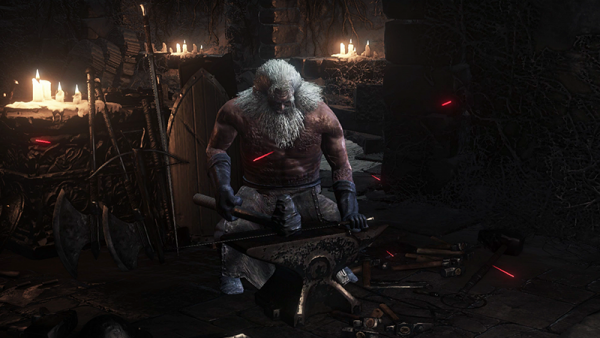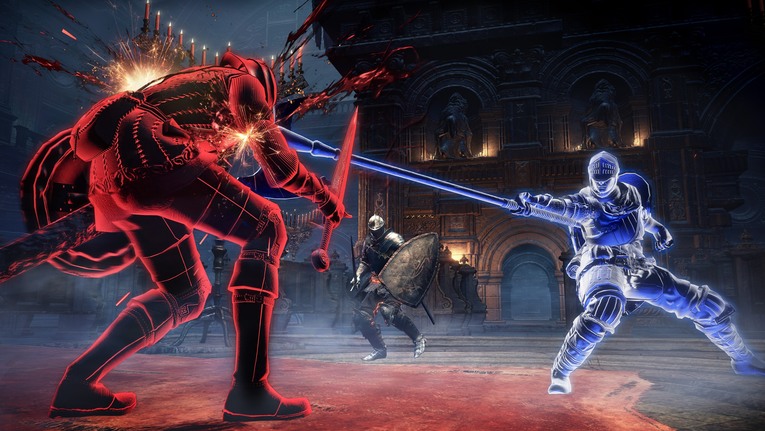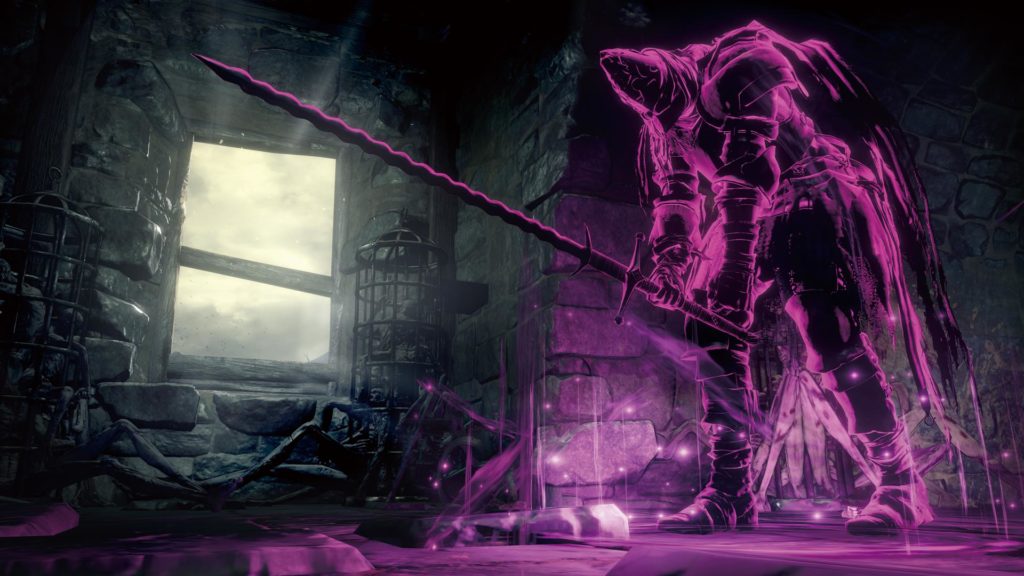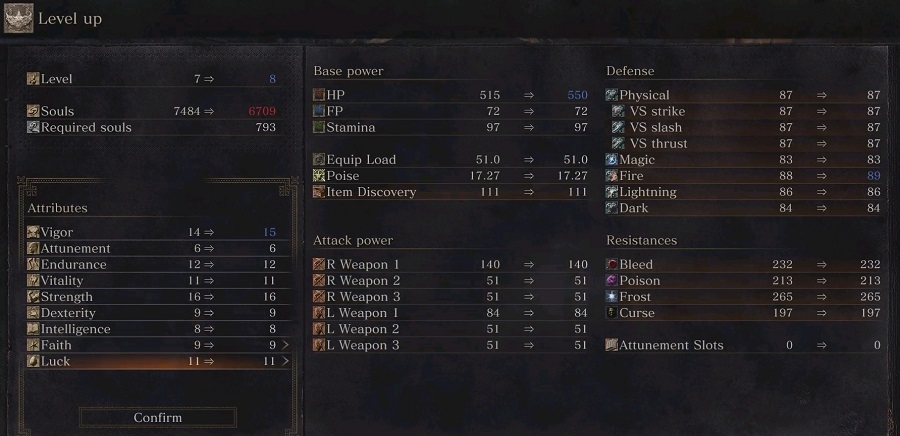Last updated on June 14, 2016
Part 2
RPG Elements
Dark Souls III also changes around the statistical distribution of character attributes once again. Still, it hasn’t changed all that much.
From Software keeps a lot of the Dark Souls II system, except they removed ADP. One exists for health, one for item/equipment load, another which raises resistances but also contains hidden effects, and the standards slow weapon (STR), fast weapon (DEX) dynamic with a similar magical balance between Faith and Intelligence (Pyromancy also requires INT this time around!). Because of the distribution, you need to think about what intangible benefits you want, since you can’t assume building a STR build gives you the item load necessary to equipment them in the future! Yes, you can equip a two-hander with a giant shield, but now that some equipment requires STR, this means a HUGE item load (Vigor is the stat you want). They want to limit overpowered options, and that makes perfect sense; the more options, the more difficult the decisions!
I know, before anyone says anything, that you can respec your character at a cost (about a 1/4 of the way through the game, and only five times from what I hear), but I honestly don’t see how that applies except for New Game + PvP builds. Certainly, you could try new things, but it’s not like the previous two games were impossible even with bad stat point distribution; that’s still true here. I never needed to respect, and thankfully that remains a thing: don’t be afraid to mess up!
Dark Souls III, because of its bonfire system, also repeats Majula in the guise of a new Firelink Shrine (a much more organized town, in fact)! Unlike Dark Souls II, though, I find this much less egregious by comparison for whatever reason. Like in Dark Souls II, you find people, free them, and get new vendors/NPCs to talk to throughout the game. But, the contrast of atmosphere between the Firelink Shrine (a “home”, if you will) versus Majula makes the former much more tolerable. Firelink Shrine feels like a safe haven, and so many useful, interesting things lie there that it’s not really a chore to go back. It’s also small, so finding your way around is no problem!

The blacksmith and upgrade systems return with some slight adjustments. For one thing, you can’t just grind materials in the same way Dark Souls let you. Instead, it appears they’ve limited enemy crafting drops until certain areas in the game. I can say with certainty that I never upgraded my Luck, but the game started giving me Large Titanite Shards like candy. I imagine they do this intentionally to encourage you to upgade your weapons; eventually, vendors start selling these items too, so there’s some further reinforcement to the player that upgrading weapons is important.
Note that I didn’t mention armor, at all, because you can’t upgrade armor AT ALL. This is a huge change! Upgrading armor made the previous two games much easier if you had the resources, and the time to grind out what you needed. Now, you can’t upgrade your defense in the same way other than by increasing your Soul Level. Dark Souls III also adds Gems as an upgrade component, most of which require finding certain embers for Andre to use (yes, the very same Andre of Astora as the first game). They function in a similar way to the elemental infusions as in the first game, although with the addition of increasing physical or magic stats straight (Heavy Gems can upgrade a weapon’s STR bonus, just for example).
Honestly, I didn’t even know what gems did until I beat the game, but it sure would have helped! I honestly like the simplification of the upgrading systems, though – Dark Souls isn’t really about tinkering with gear for 30 minutes at a time, but about exploration and combat; Dark Souls III seems to know that as much as anyone, and that’s really where all the focus went. In that sense, Dark Souls III, to me at least, doesn’t feel like as much of an RPG with micromanagement, but rather a series of distinct choices on gear, weapons, and the like. I appreciate this approach a lot more!

Online Play
I’m honestly not very good at PvP, but I feel that the online experience adds a lot to Dark Souls. There’s always the sense of danger that someone, somewhere wants to invade your world and kill you. Even safe areas like a bonfire turn off during such invasions, so you need to kill the invader or lose all your Souls. That’s what makes Dark Souls tense even when the situations lacks tension – invasions could happen.
Thankfully, unlike its immediate predecessor, invaders come fast and furious even in your first playthrough. I’m pretty certain that nearly every invader killed me, but I’m sure that was due to my own incompetence more than anything else. However, I can say one thing: there’s just too much healing in this game. A one on one duel just isn’t much fun when both sides can heal themselves with 10+ Estus Flasks. One guy invaded me in the area right before the last boss, and we went on for a few rounds before I just decided to kill myself and get it over with. Maybe that’s due to the increased skill level of all players involved, but I found it stupendously boring on your first go; I’m not exactly inspired to try out more PvP.
The covenants feel as ancillary as they did before in the previous games; still, they now can affect quest lines with NPCs you meet along the way. PvP is still required for the cool rewards, but that’s about the long and the short of the system unless you like helping/tricking/invading people and making fun Youtube videos about it. The covenant system didn’t make much sense or become necessary at all before, and now said systems look even more unnecessary this time. That’s how an unfinished part of a game becomes a feature, I guess!

Unfortunately, the problem of an expanded messaging system in the game remains. In Souls games, online play offers you the benefit of other players leaving hints here and there. The limited text system meant that, at best, the hints either confused the heck out of you (what is a beanpole or a fatty?), gave you useful information (bonfire ahead), or simply trolled you beyond belief (illusory wall ahead). This meant that, while players could help, you still needed to piece together the solution.
In Dark Souls III, they’ve massively expanded that vocabulary once again, for the worse. Sometimes they’re just far too clear and provide way too many hints. It breaks the sense of surprise and dread when you see a bunch of messages saying “Don’t You Dare” right before a switch. You lose the fun of figuring things out. If I had to go back and do it again, I’d just play the first time offline to avoid the massive spoilers. Sometimes you’ll just activate them by accident though, and you’ll wish you hadn’t.
Furthermore, don’t summon other people or NPCs for regular play or boss fights. I realize that they want to encourage people to play together, but trust me. Any sort of summons on bosses basically trivialize the encounter, even when they get a larger health pool. When they focus on another player, they ignore you entirely, giving you free reign to do whatever you want. I followed that advice to the letter this time, and fought every boss solo – I recommend you do the same!
In sum, the online is certainly an improvement, but a lot of the baggage from Dark Souls II gets carried over. Sometimes, it’s better not to ask for any help at all! If you don’t want to ruin this experience at all, it’ll take some hard work on your part. The spoils, however, remain as that intangible sense of accomplishment and conquest. Still, there’s a few more things to discuss…

